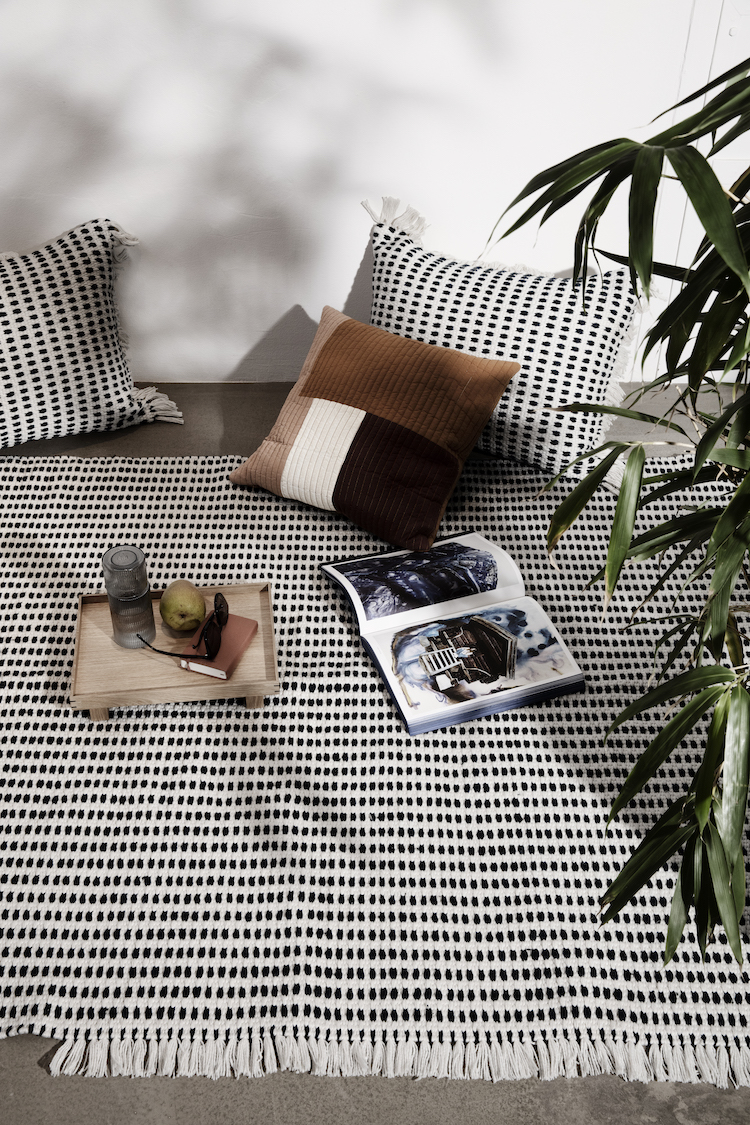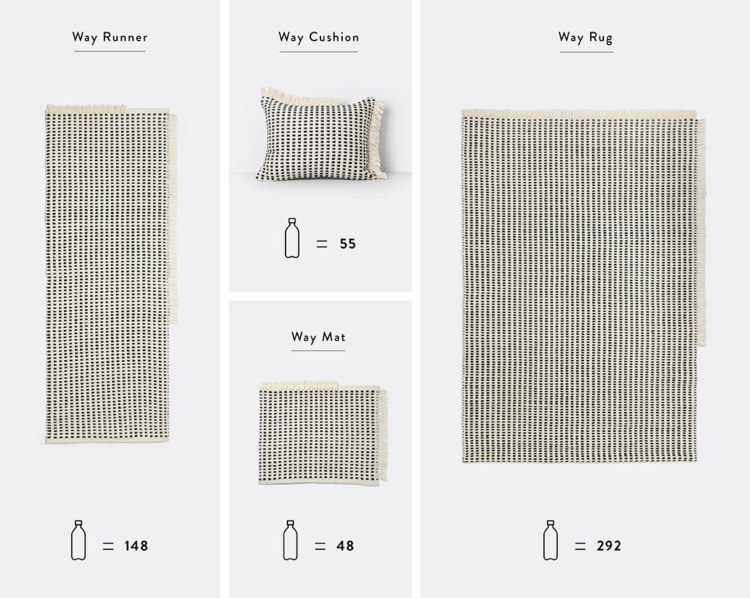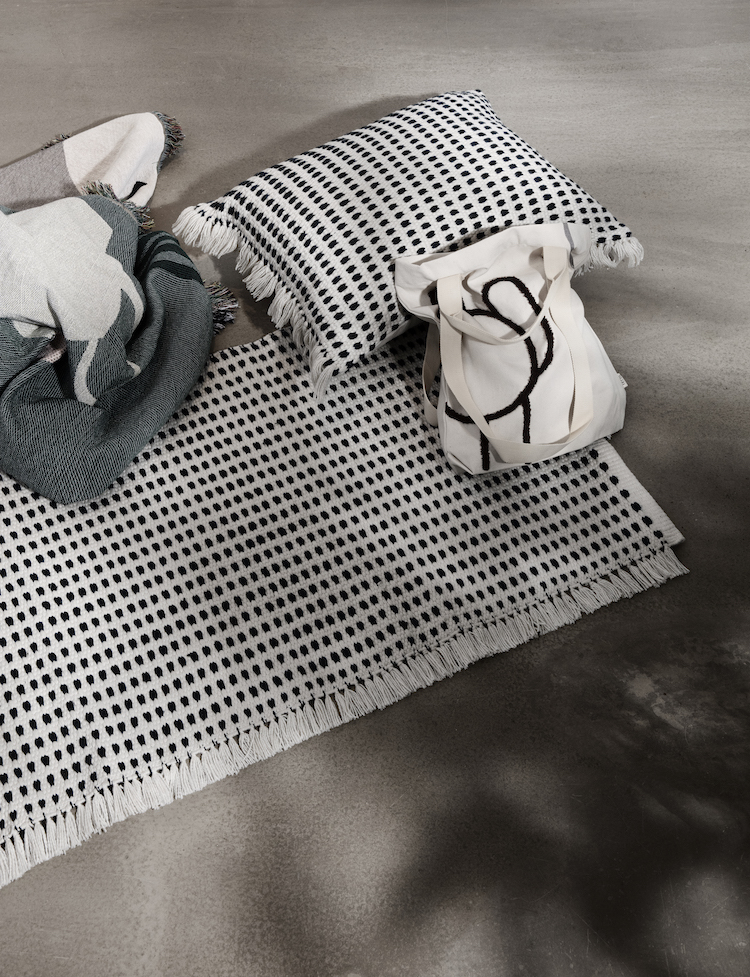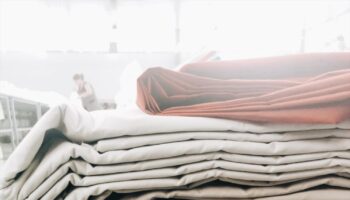Firstly can I thank you all so much for your positive response to my Do Less Harm campaign. I was glad that so many of you felt the same way and also concerned at the lack of information that is out there. So work on compiling the directory has begun. In the meantime I thought I would show you interesting and relevant things where I find them and this is one of those.

The Danish brand Ferm Living has launched a small collection comprising a rug, a runner, a cushion and a mat which are all made from upcycled plastic bottles and recycled polystyrene as part of its ongoing mission to produce its products in a more sustainable way every year. The company first launched a collection of organic tea towels in 2008 and has been working towards this goal ever since. If the entire collection sells out in a year, they will have re-used and reduced 270,000 plastic bottles.
Trine Anderson, the founding partner and creative director, said: “Our aim is always to do better than we did the year before. This goes for our designs, our people as well as the environment. With the launch of the Way series we stay true to our design language without compromising form and function while reducing waste – it all comes together and this, to me, is what sustainable design is all about.”

The other point to note about this collection is that it will fit seamlessly into most houses. You can use it inside or out but the deep blue and white pattern works with florals as well as more colourful geometric and even vintage Persian rugs so it’s immensely versatile. It can also go in the washing machine or be wiped clean so will work well under a kitchen table or in a playroom where there is liable to be spillage.

The rug is £229 and the cushion is £85. And yes, sometimes buying products like these does cost more. If it’s out of your budget then ask questions of the company you do want to shop from and see what their policies are towards disposal and sustainability. I was contacted by a company the other day that asked me to write about them in return for some products. They said they operated a paper free office but, as a start-up that was all they could manage at the moment. I asked where they sourced their products. They said everything they sold was sourced in the UK but they didn’t know where it was manufactured. Now to me that felt slightly out of step with the times. As discussed before, we may only be able to take small steps, to try and do less harm than no harm but it doesn’t cost anything to ask questions and find out where things come from. And, at the very least, if you have to dispose of it yourself make sure you do it in the best way possible.
That said, these rugs are a classic design that won’t go out of fashion and will last for ever so you can just move them round and round the house as the mood takes you.





How about a ‘do NO harm’ campaign where people stop buying things or redoing their houses every two seconds?
I mean fundamentally your blog is based on an environmentally destructive industry. It doesn’t matter if you use Farrow & Ball ecopaints (‘eco’ only in name) or buy some all natural materials rug from John Lewis, they all contribute to the staggering environmental issues that come with their production.
I recognise that people mean well but really isn’t it time we face up to facts that campaigns like ‘do less harm’ are just greenwashing – a way for people like you to justify to themselves their relentless contribution to environmental destruction as being slightly less than it was before.
I hear your point. This is not about greenwashing on my part nor do I feel the need to justify myself. I am trying to provide a resource and information to people so that they can make their own, hopefully better, choices, about what they buy to put in their homes. People are always going to buy/rent/need somewhere to live. They are always going to want to decorate those places to make them feel comfortable and safe and provide for their needs. That isn’t going to stop. Surely providing information that helps them make more sustainable and environmentally safe choices is a good thing. If we all do that at the bottom and reject the plastic packaging and the companies that dispose to landfill then changes will happen. I appreciate we don’t have much time but in the absence of big business leading the way we have to start somewhere.
Thank you for replying. I also hear your point. Of course people want to decorate their homes – humans have been doing it for millenia. It’s intrinsic to our nature. A resource of more sustainable producers a great idea.
But every six months at the whim of the latest trends? That may be somewhat of an exaggeration but i’m sure you take my point. Even natural materials take a huge toll on the environment. Water usage for crops like cotton, illegal logging of forests -our last great hope for carbon-sinking , transport of the above using fossil fuels and other associated pollution issues related to the global transport of freight….
It’s overwhelming and it’s overwhelming because it’s fundamentally tied into big business and the way capitalist economy works. We essentially have to change everything to survive as a species. Which obviously isn’t going to happen.
I just feel that with the scale of environmental issues we’re facing on a global and species level… what justification is there for buying anything new when you can get it second hand and decorating your house for anything less than life.
The cereal crops are expected to fail at only a 2 degree average global temperature rise. That’s most of the world’s calories. If that happens as science expects then there will be mass global starvation that cannot fail to effect even the gilded towers of the western middle class. It will much worse for the poor of the world.
Sorry if I sound somewhat raving. This area was the focus of my decade in academia. I recently got out because frankly ‘ignorance is bliss’ is true. Knowledge in this case simply allows you to see all of the disasters coming without being able to do anything about it. Humans are too good at lying to ourselves until disaster is upon us.
Ironically, I was looking at your blog for decorating tips – mostly your psychology of colour series. I’m about to buy my first house and intend to do it up with actual ecopaints (either claybased or casein – haven’t found a reliable source of information on which does the most damage – because excavating clay and getting milk from dairy herds still have environmentAl impact even if less than dulux and farrow and ball) and secondhand everything in good materials.
When I saw your campaign it just triggered something in me. There are so many people like yourself who mean well and yet have aims and goals that don’t really change anything. We use it as a kind of shield I suppose. So that when the excrement hits the fan we can say to ourselves ‘well it wasn’t me because I bought recycled plastic rugs’.
Not raving but passionate. However, you have alighted on the very problem that I am trying to address. You were searching for something for your house and you couldn’t find it and that is what I want this directory to help with. This is your field and you can’t find the information so imagine all the other people who don’t know much but just know that they want to do better. You can accuse me using this as a shield if you like, or you can work with me to help build this directory to give people a reliable source of information that they can use. My book, and this blog, has been all about helping people find their own style and their own taste so they can buy less and don’t have to change their decor every few months. It is, in many ways exactly about decorating for life. It’s up to you. If you want to tell me about companies you have found so I can add them to the directory you can email me on Kate at madaboutthehouse.com. If you feel that that would be contributing to a “greenwash” and that this directory is pointless then I accept that that is your point of view and there is nothing more to be said between us. Of course, some people will be smug about their single recycled plastic rug, some people don’t care about any of it. Others will see that rug, learn more about the issue and build from there. I would love you to help me on this but I understand if you don’t want to.
Hi Kate,
You make excellent points. I would actually love to contribute. I don’t have specific makers to recommend though because I’m still focusing on information gathering at the moment. The only thing I’d be able to contribute is information from a scientific POV. If you would be interested in that then I would be glad to hear from you. I’ll put my email address in a separate comment to you.
I’d be grateful if you wouldn’t publish this comment as I don’t normally share my email address:
Stanfordsam at Hotmail dot Co dot uk
Do also take a look at Weaver Green who are based in Devon – they have been making their lovely rugs and other homeware products from recycled plastic yarns for a good while now.
And don’t miss the amazing Angie Parker – a super-talented handweaver based in Bristol – known for her colourful interpretations of Scandinavian weaving patterns such as Krokbragd. Last year she brought out a diffusion range of Eco Rugs (I wrote about her here https://www.colourfulbeautifulthings.co.uk/bodacious-handwoven-eco-rugs-from-angie-parker-textiles/).
That said, I agree with other comments, in that not using the plastics in the first place needs to be a critical priority. But whilst we have, literally, oceans of plastic waste already existing, then any practical way to use it has to be a plus (without causing further environmental damage).
Maybe it’s also worth mentioning that these rugs feel incredibly wool-like, being a little rough and quite natural-feeling to the touch.
Hi Kate – I am a huge fan of your Do Less Harm campaign and applaud your efforts. I am a bit confused by the Ferm Living rug collection. Yarn made from recycled bottles has been available for years – in all colors of the rainbow. There is a big industry in the US that utilizes these yarns in all manner of upholstery fabrics for both the commercial and residential industry. While making a point of using these products does help with recycling, it does not address the root problem – which is too much plastic to begin with. And if you were to visit a facility that turns these plastic bottles into yarn, you would not be happy with the environmental impact made in the process. To do less harm – we all need to be more resistant to plastic packaging and we all need to use cloth shopping bags. I think the Ferm Living rug collection is nice – but it is not particularly innovative when it comes to using recycled plastic bottles.
John Lewis also do a range of rugs called Weaver in pink, teal, blue, grey, yellow and green all made 100% from recycled bottles, the prices are good too at only £65 for the smallest up to £390 they can be used both indoors or out so are fabulously versatile see https://www.johnlewis.com/search?search-term=weaver%20rug
We do want to see more of your discoveries Kate, but I think the Ferm designers missed the mark with their colour choice of dark blue. There would, I think, be a far bigger market for the rugs in particular, if the dark blue was black.
Are they like Weaver Green rugs? I have one of them and it’s great.
I saw a company called Weaver Green at the Chelsea Flower Show that did a huge range of gorgeous rugs, runners, cushions, throws and bags – all made from recycled plastic bottles. What surprised me was how soft they were. Washable too. And fair trade. Win win!
Hi Kate. You should check out http://www.weavergreen.com. Based down in Devon, these guys make a fabulous range of woven products using recycled plastics, including rugs and cushions. Loads of styles to choose from. The materials are not actually woven in the UK, but the company is and sustainability is at its heart. I bought one of these rugs a few years ago. Started life in my kitchen (as it can be thrown in the machine) and it’s now making a great outdoor lounge space. Super versatile.
Today’s article is fine and well done Ferm ; but I was surprised you didn’t mention the excellent http://www.weavergreen.com which has been doing the very same for quite some time with consequently much more variety..,
I think the problem for smaller companies is that they are often buying from wholesalers who are notoriously difficult to ask questions of. I too like you am on a mission to cut down on waste but feel wholesalers (I only know this with interiors) should be more transparent. Unless a company is manufacturing for themselves it’s hard for them to cut down on waste or track a product through every stage of manufacture. Having said that if every small business started asking questions and putting pressure on we would hopefully see change. The other question I suppose we should ask is even if a company say they recycle, do they actually do it? We shared a warehouse with a very large, well known mattress company who said they recycled their returns. Returned mattresses were stacked everywhere, I never saw one being recycled, it seemed such a shame as they could have been gifted to low income families or homeless shelters. If they are going to talk the talk, they should also walk the walk. I hope you bring about change, if anyone can do it, you can.
Although I’m not normally mad on products that aren’t made from natural materials I absolutely love love the look of this rug, which I bet would be brilliant in the garden. It’s nice to see brands like Ferm using their huge platforms to introduce these kinds of ranges and I also love that you are asking questions of the brands wanting to partner with you – I agree paper-free offices doesn’t seem like much of an effort these days!